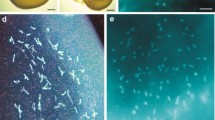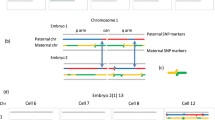Summary
The pachytene configurations formed in the ovary of a mosaic 18p-;iso 18q human foetus (22 weeks gestation) are analysed using a surface spreading technique. Three features of interest are the apparent meiotic delay of oocyte development, oocyte degeneration, and the triple pairing which occurs in one cell line when the iso 18q both pairs with itself and with the normal chromosome 18.
Similar content being viewed by others
References
Chandley AC, Goetz P, Hargreave TB, Joseph AM, Speed RM (1984) On the nature and extent of XY pairing at meiotic prophase in man. Cytogenet Cell Genet 38:241–247
Coerdt W, Rehder H, Gausmann I, Johannisson R, Gropp A (1985) Quantitative histology of human fetal testes in chromosomal disease. Pediatr Pathol (in press)
Froster-Iskenius U, Coerdt W, Rehder H, Schwinger E (1984) Isochromosome 18q with karyotype 46,XX,i(18q). Cytogenetics and pathology. Clin Genet 26:549–554
Gillies CB (1981) Electron microscopy of spread maize pachytene synaptonemal complexes. Chromosoma 83:575–591
de Grouchy J (1969) The 18p-, 18q- and 18r syndromes. Birth Defects 5:74–87
Jenkins G (1985) Synaptonemal complex formation in hybrids of Lolium temulentum x Lolium perenne (L). Chromosoma 92:81–88
Johannisson R, Gropp A, Winking H, Coerdt W, Rehder H, Schwinger D (1983) Down's syndrome in the male: reproductive pathology and meiotic studies. Hum Genet 63:132–138
Luciani JM, Devictor M, Boué J, Morazzani M-R, Boué A, Stahl A (1978) Étude de la méiose ovocytaire chez un foetus trisomique 18. Comportement du chromosome surnuméraire et identification du bivalent 18. ann Génét (Paris) 21:215–218
Miklos GLG (1974) Sex chromosome pairing and male fertility. Cytogenet Cell Genet 13:558–577
Moses M (1977) Microspreading and the synaptonemal complex in cytogenetic studies. In: de la Chapelle A, Sorsa M (eds) Chromosomes today, vol 6. Elsevier/North Holland Biomedical Press, Amsterdam, pp 71–82
Peters H, Byskov AG, Grimsted J (1981) The development of the ovary during childhood in health and disease. In: Coutts JRT (ed) Functional morphology of the human ovary. MTP Press, Lancaster, pp 26–34
Russell P, Altschuler G (1975) The ovarian dysgenesis of triomy 18. Pathology 7:149–155
Solari AJ (1980) Synaptonemal complexes and associated structures in microspread human spermatocytes. Chromosoma 81:315–337
Speed RM (1984) Meiotic configurations in female trisomy 21 foetuses. Hum Genet 66:176–180
Speed RM (1985) The prophase stages in human foetal oocytes studied by light and electron microscopy. Hum Genet 69:69–75
Speed RM, Chandley AC (1983) Meiosis in the foetal ovary. II. Oocyte development and age-related aneuploidy. Does a production line exist? Chromosoma 88:184–189
Sung WK, Komatsu M, Jagiello G (1983) A method for obtaining synaptonemal complexes of human pachytene oocytes. Caryologia 36:315–324
Wallace BMN, Hultén MA (1983) Triple chromosome synapsis in oocytes from a human foetus with trisomy 21. Ann Hum Genet 47:271–276
Author information
Authors and Affiliations
Rights and permissions
About this article
Cite this article
Speed, R.M. Prophase pairing in a mosaic 18p-;iso 18q human female foetus studied by surface spreading. Hum Genet 72, 256–259 (1986). https://doi.org/10.1007/BF00291890
Received:
Issue Date:
DOI: https://doi.org/10.1007/BF00291890




